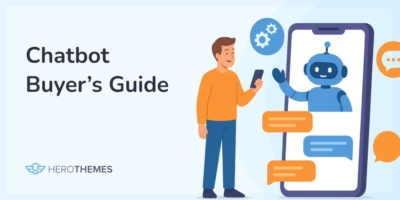9 Best Self-Service Solutions (Cut Support Tickets in Half)
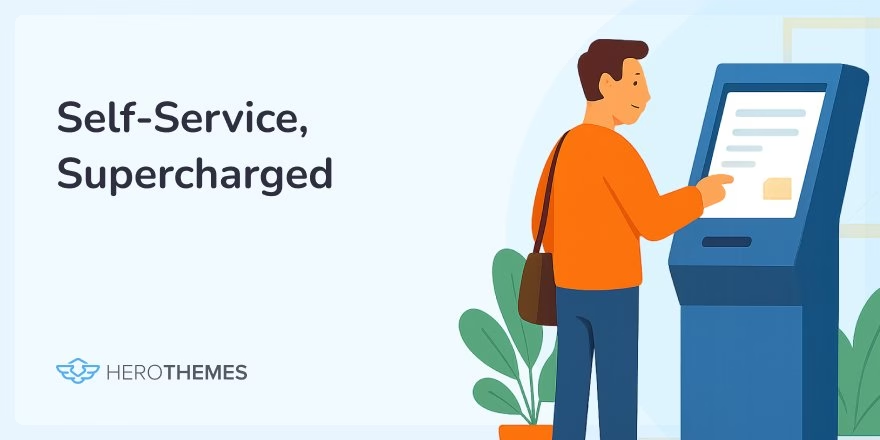
Ever felt like you and your support team could use a superhero sidekick?
Self-service solutions can be just that, empowering your users to help themselves while you focus on bigger issues.
Self-service can be a game-changer for SaaS platforms, eCommerce stores, IT teams, and any business juggling customer questions.
Customer self-service solutions come in many different forms. In this guide, we will explore all of the possible options to help you choose the best self-service solution for your business.
In This Guide
What Is a Self-Service Solution?
A self-service solution is any tool or channel that lets users answer their own questions or solve their problems without talking to a human agent.
It’s like giving your customers a mini-support portal or guidebook.
For example:
- An online help center full of step-by-step guides
- An FAQ page
- A chatbot
- A community forum
According to HBR surveys, about 81%1 of customers try to find a solution themselves before contacting support. They want to fix issues on their own, at any time, without waiting in line.
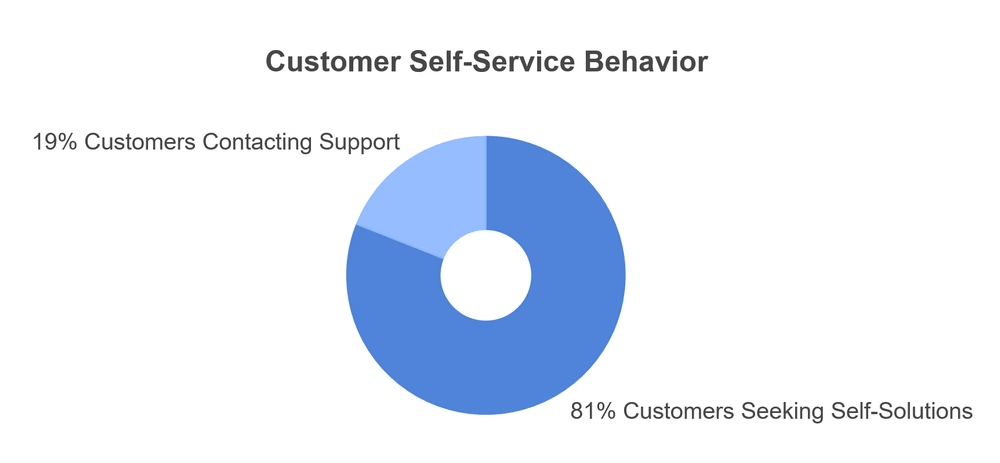
If someone lands on your site at 2 AM, a self-service portal or knowledge base is their midnight mechanic. Instead of waiting until morning, they can search for “how to reset my password” or “set up feature X” and get instant answers.
That’s exactly why self-service is called a solution, it solves problems even when nobody from your team is at a desk.
Benefits of Offering Self-Service Customer Support
Here are the key benefits of having a self-service option:
- Faster Resolutions, Anytime Access: Customers solve problems immediately. By offering answers on-demand, you reduce waiting and frustration.
- Higher Customer Satisfaction (and Loyalty): Being able to fix an issue on your own feels empowering. When customers find solutions quickly, they’re happier and more likely to stick around.
- Reduced Support Costs: Every support ticket handled by an article or bot is cost-effective. Self-service interactions (people reading docs or bots replying) are essentially “free once set up.” This means the more you can deflect common issues to self-help, the more your team can focus on tricky cases.
- Consistent Answers / Single Source of Truth: A knowledge base article or FAQ ensures consistency, whereas multiple agents might give slightly different advice.
- Empowered Team, Less Burnout: Rather than answering the same beginner questions dozens of times, they guide customers who already did their homework or handle more complex issues.
- Scalability: You don’t need to hire 10 new agents when 10 more customers arrive; you just add articles or improve your chatbot. Scalability is huge for SaaS/IT: one help article serves infinitely many readers.
- Valuable Insights: Good self-service tools often track what users search for, what articles they view, and what they rate as helpful.
- 24/7 Availability: If you have global customers or busy professionals, your portal never sleeps.
Best Self-Service Solutions (Types)
There are several types of self-service options, each fitting different needs. Here are some of the most common types:
1. Knowledge Base / Help Center
A structured repository of articles, guides, manuals, and FAQs.
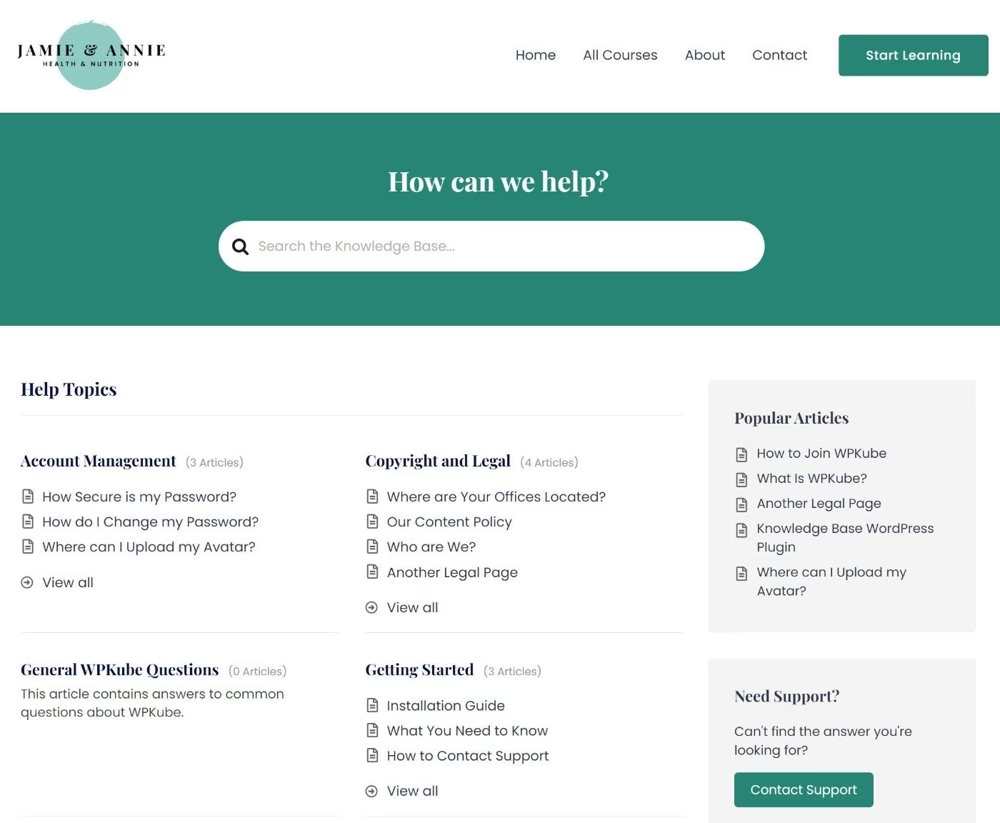
This is often the core of self-service and like your product’s instruction manual online.
A WordPress knowledge base plugin like Heroic Knowledge Base can help you build one, complete with live search and analytics.
2. FAQ Page

A simple list of Frequently Asked Questions and answers on your site to let people quickly click through common questions.
Explore:
What Is FAQ? With Examples & Everything You Need To Know
5 Tips to Putting Together the Perfect Product FAQ
3. Chatbot / Virtual Assistant
An AI-powered or scripted chat window that can answer questions. This might be something like a ChatGPT-based assistant or a preset chatbot built into your site.
The bot can pull answers from your knowledge base or AI models.
For example, Heroic AI Assistant to turn your documentation into a chat experience. which is trained on your knowledge base content.
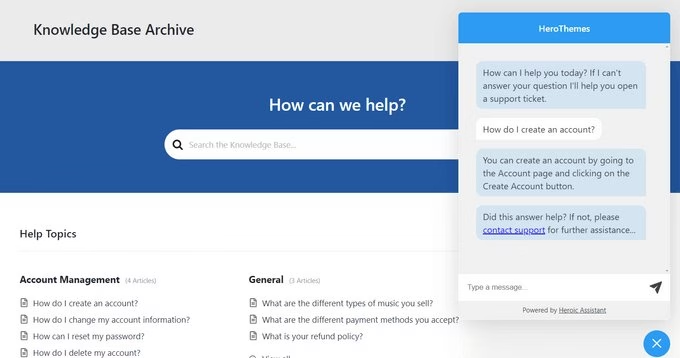
Explore:
11 Best Free WordPress AI Chatbot Plugins
Best AI Chatbots for Customer Service (2025 Edition)
11 Internal Chatbots for Employee Support and Productivity
4. Community Forum / Discussion Board
A place where users help each other. Here customers and even your staff can post questions and answers.
StackExchange-style forums or an open-source forum (like Discourse) let customers crowdsource solutions. It builds a sense of community.
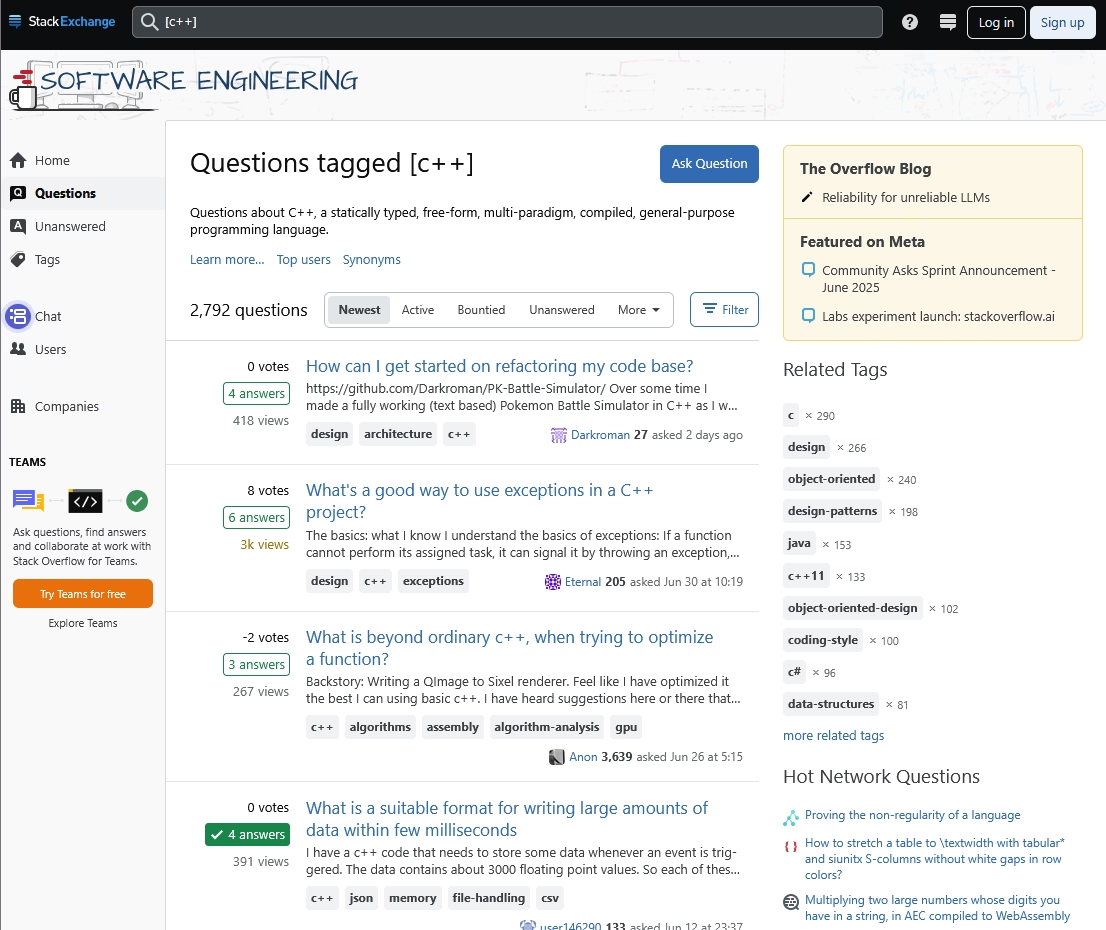
Explore:
The 5 Best WordPress Forum Plugin Compared (2025)
9 Great WordPress bbPress Forum Examples To Inspire You
5. Support Portal / Success Portal
A unified hub (often called a customer portal) where users can not only find help articles but also manage their account, tickets, or settings.
It’s like a one-stop app: docs, billing info, and ticket submission all in one place.
Many businesses create a customer success portal where the knowledge base, FAQs, and user account all live together as an “ultimate” self-serve center.
6. Video Guides and Tutorials
A library of how-to videos or screen recordings. This isn’t a “software tool” per se, but hosting tutorials on YouTube or an internal site lets people see the steps in action.
7. Interactive Wizards / Guided Tours
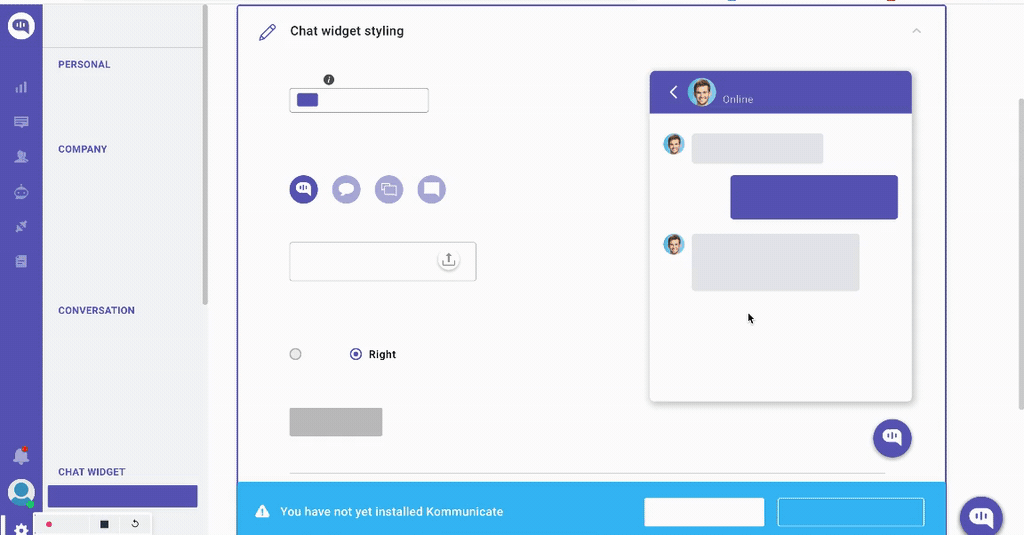
Userpilot’s interactive onboarding example
Tools that walk users through a process in-app (like an onboarding tour). These help users learn by doing, a kind of proactive self-service.
8. Phone/IVR Self-Help
Even phone support can have self-service with automated menus (press 1 for account info, etc.) or voice bots with pre-recorded answers
A good example here would be booking an appointment by calling and choosing available options.
9. Search Widgets
A floating search box on your site that any page visitor can use to find help articles without leaving the current page.
A single solution might not work perfectly. In practice, I usually advise clients to start with a solid knowledge base backed by a great search feature, then layer on other channels (like a chatbot or forum) as needed.
Best Customer Self-Service Software 2025
Now let’s look at the best self-service software to implement ideas I have discussed in the above section.
I’m focusing on tools and software, especially ones I’ve tried or that fit neatly into the scenarios above.
1. Heroic Knowledge Base
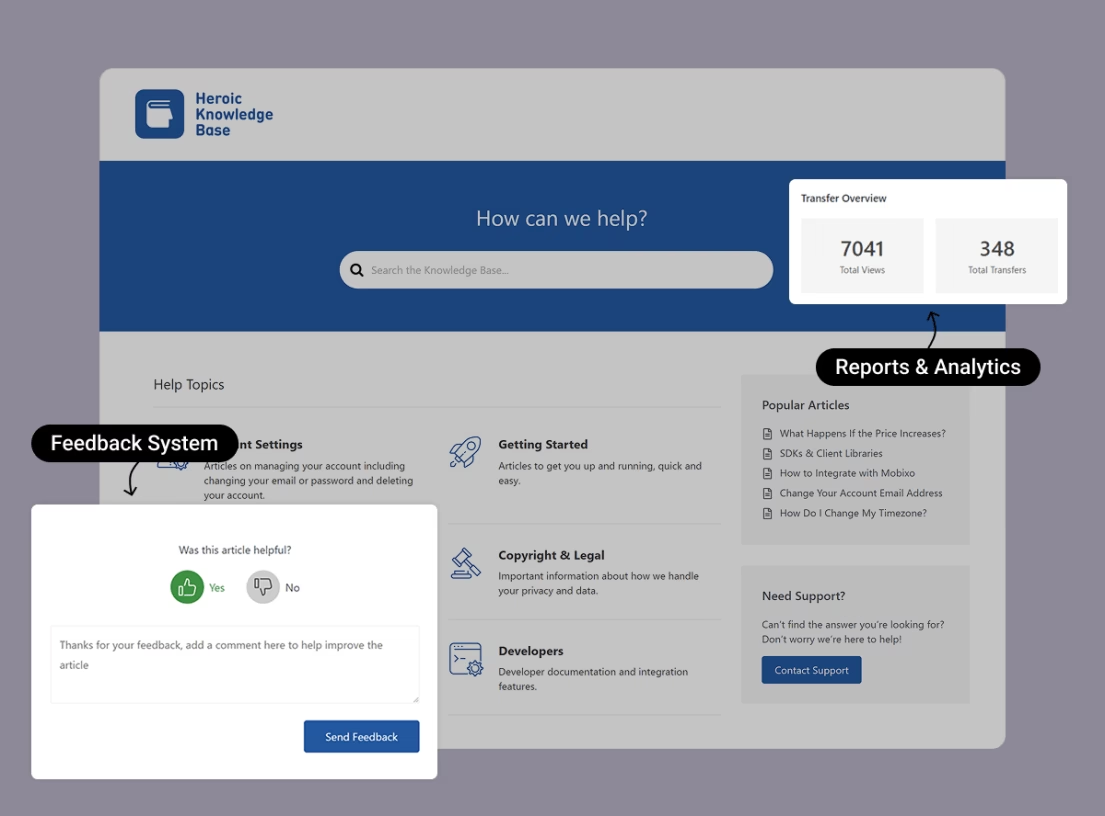
Heroic Knowledge Base (Heroic KB) is a feature-rich WordPress plugin. It’s designed specifically to build a self-service portal or knowledge base in minutes.
With over 31,000 customers, from blogs to big brands, it’s a proven solution for creating self-service portals. It’s definitely worth the budget for a serious product or service.
Key Features
- Instant live search (with suggestions)
- Categories, table of contents, breadcrumbs and other navigation options in articles
- Analytics and reports: article view tracking, helpfulness ratings, so you can see what customers read or who still hits “human support” buttons.
- Embed the help search in other pages, or use the Instant Answers chat widget (AI Assistance) for on-page support.
- Restrict content to logged-in users for an internal helpdesk.
- Designed with SEO in mind: Clean URLs, schema markup so your help articles show up in Google search for public FAQs.
Pricing
There’s no free tier, but Heroic Knowledge Base pricing is competitive given the features. The Essential plan starts around $68/year for one site.
Considering a typical helpdesk subscription is often hundreds per month, this offers a good value for businesses.
2. Heroic FAQs
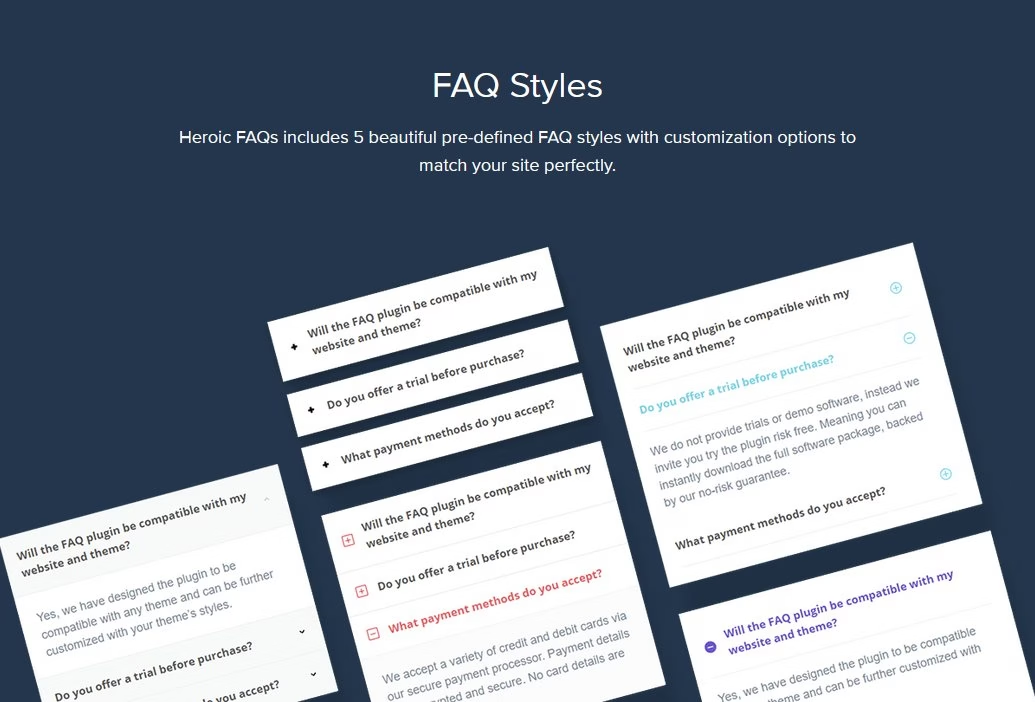
Heroic FAQs is a companion plugin by the same makers of Heroic KB. It’s specifically for building FAQ sections. It actually comes bundled free with Heroic KB licenses, or you can get it alone.
In practice, it lets you create beautiful FAQ lists anywhere on your site (like on landing pages or resource pages) with a drag-and-drop interface.
Key Features
- Create an “accordion” style FAQ.
- No coding skills needed as you create questions and answers with interaction drag-and-drop builder.
- Organize FAQs into groups, reorder them by drag and drop, and style them with one of 5 built-in templates.
- Supports images, videos, and rich text in answers, so your FAQs aren’t just plain text.
- It’s mobile responsive and includes SEO-friendly markup.
Pricing
Heroic FAQs is essentially free with Heroic KB. If you have a Heroic KB license, you get FAQs included (and even a Glossary plugin as well).
If you just want FAQs by themselves, the plugin costs about the same as the KB license: roughly $67/year for one site, with standard support and updates.
Heroic FAQs is a solid time-saver. It’s not a flashy ticketing tool, but for self-service and managing FAQs elegantly, it’s a worthy addition.
3. AI Chatbot (Heroic AI Assistant and Other Bots)
AI-driven chatbots are shaking up self-service. These can range from simple rule-based bots to advanced assistants built on large language models (like ChatGPT).
The idea is: a visitor clicks on a chat window or widget, asks a question in plain language, and gets an instant answer.
Recently, HeroThemes released Heroic AI Assistant, which ties into your knowledge base content and uses AI to create a chatbot.
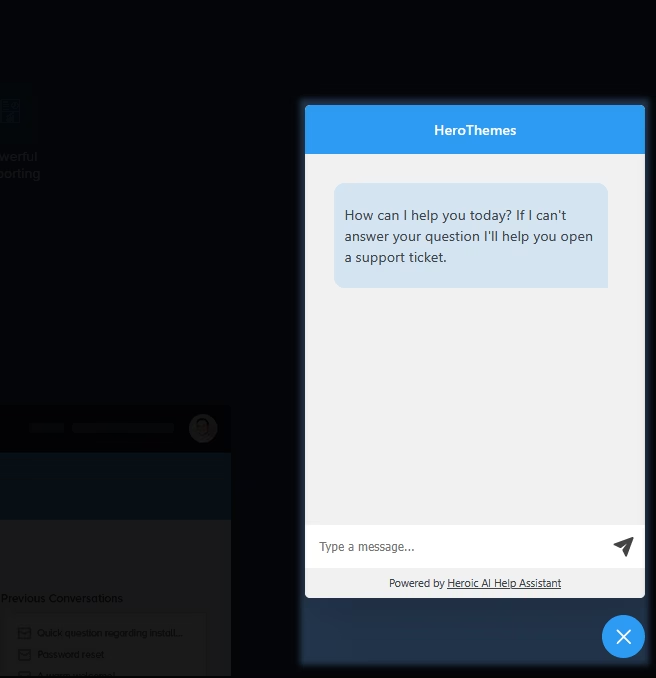
Other tools like Landbot, Tidio, or direct ChatGPT embeds work too.
Key Features to consider in AI Chatbot:
- A good AI chatbot should understand queries and pull responses from your docs or an FAQ.
- Effortless customization and setup.
- Ability to deliver dynamic Q&A sessions, meaning the bot can say “Can I help you with resetting your password?” as if you were chatting with support.
- Because it’s AI, it can handle variations in phrasing and even clarify follow-up questions. The Heroic AI Assistant is embedded on your site via a chat icon, so it’s available anywhere (no extra tab switching). Other chatbot services offer visual flow builders and analytics. The key is, they give a conversational feel: not a form, but a back-and-forth.
Pricing
AI features often come at a premium. Heroic AI Assistant is included with the Heroic KB Pro plan (so no extra cost beyond that $239.60/year).
If you use ChatGPT or another AI API, there may be token costs. Purely rule-based chatbots (with canned answers) might be cheaper or even free.
Chatbots take effort to set up well, you need good answers behind them and possibly monitoring. But they can dramatically cut simple questions.
Considering GPT-like tools are everywhere, a good chatbot can be a friendly 24/7 self-service agent. It’s not yet a full replacement for human tone, but customers appreciate that instant “something’s happening” when they click it. I’d say: if you have the content ready, give chatbots a try.
4. Community Forum Software (Discussion Platform)
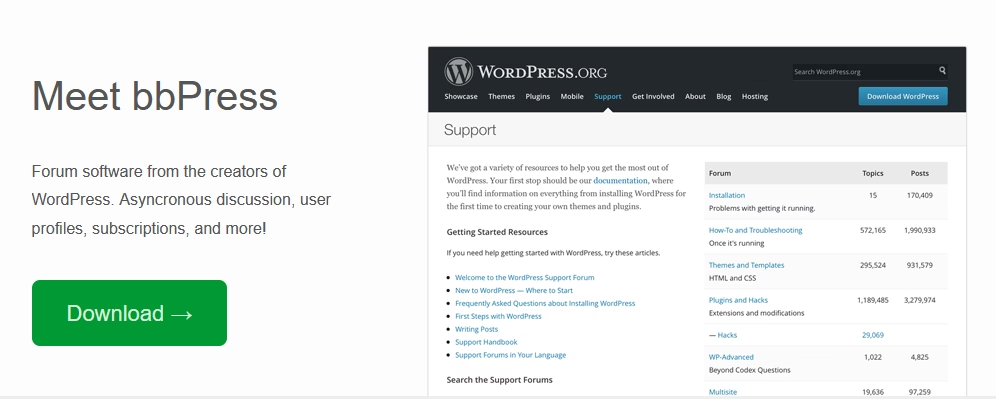
A community forum is a platform (often a website or board) where customers ask questions and answer each other’s queries.
Famous examples are StackOverflow (for developers) or company forums for products. It’s a self-service support crowd-sourcing hub.
You can use open-source software like Discourse or phpBB, a hosted solution, or a WordPress forum plugin. This isn’t a widget; it’s a whole section of your site where users log in and post discussions. And it works great alongside knowledge base and chatbot.
Key Features to Consider When Building Community Forum:
- Common features include categories, voting (to surface the best answers), reputation points, and easy search.
- The knowledge base often works alongside the forum: people might read an article and then see “Related forum posts” or vice versa.
- SEO friendly, so every answered thread potentially shows in search too.
- User roles and restrictions for managing the community.
Pricing
Many forum platforms are free or open-source (cost is hosting and maintenance).
For example, Discourse is free if self-hosted, or there’s a paid hosted plan. You don’t need a big upfront cost, but moderators are key (someone must keep the forum healthy).
The value comes from community engagement. It’s hard to quantify, every time a user posts a question about a bug, another user or agent answers it. Over time, those answers build a living archive. If you have a passionate user base (or want one), a forum is gold.
5. Customer Portal / Success Portal
A customer portal (sometimes called a customer success portal) is an all-in-one hub for your users. Instead of just a help center, it’s an integrated area where customers can not only find support articles but also manage their account, subscriptions, or projects.
Customer portals can include a personalized FAQ section, ticket tracking, and links to a knowledge base or forum.
The idea is to give customers a one-stop place for everything related to your product.
Key Things to Consider When Building Customer Portal
Building a portal usually means combining several tools. Common elements are:
- A support knowledge base
- Ticket submission form
- Section to view past tickets or orders
- Integrated tutorials and a live chat widget
The portal’s homepage can highlight trending issues (“Top Questions”), links to documentation, and buttons to submit a new ticket or start a chat.
An ideal portal has a search bar front and center so customers don’t have to hunt for info.
Pricing
If you’re on WordPress, your cost is mostly the sum of the parts (KB plugin + helpdesk + whatever) and development cost.
For example, you can use Heroic products for a knowledge base, chatbot, FAQs and ticketing system. Paired with a form submission plugin like WPForms (which is free), and a good theme to allow you to easily build a portal.
A customer portal for self-service can easily cost you $200/year for tools, plus development time or cost.
On the SaaS side, some portals are included in premium plans of CRMs (HubSpot Service Hub, etc.). These can be hundreds a month, but they bundle many services.
Customer portal value comes in making your customers feel taken care of. A seamless portal experience can reduce churn: customers who have easy access to all their info stick around longer.
6. Video Tutorials / Screen Recordings
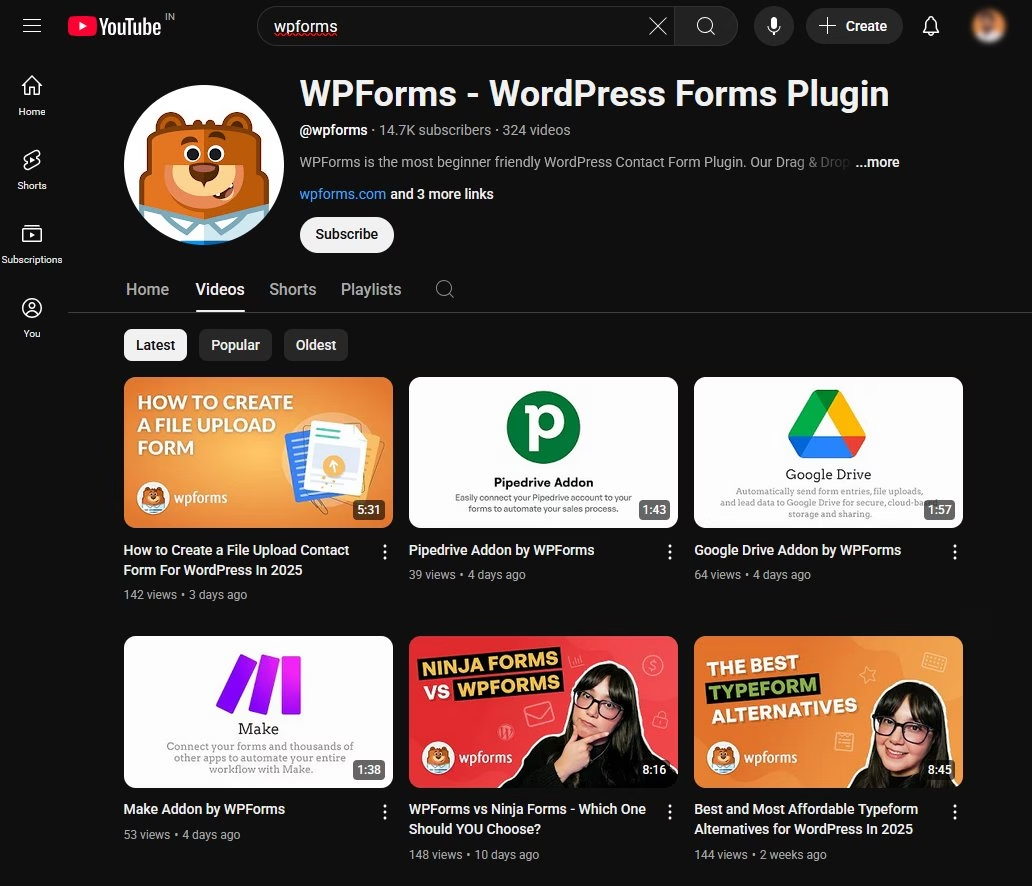
While not “software” in the traditional sense, video guides are a powerful self-help tool. Think of them as a mini-class for your users.
Quick walkthrough videos, hosted on YouTube, Vimeo, or embedded on your site can explain processes in a dynamic way.
For example, “how to set up your new account” might be a 2-minute screen capture with voiceover.
Making videos is extra work, but customers do appreciate it. People sometimes prefer to sit back and watch rather than read instructions.
Key Things to Consider When Offering Video Tutorials
- Video is visual and engaging, and it is great for showing a sequence of steps or high-level overviews.
- Create video playlists by topic.
- Tutorials can live in your knowledge base or on a dedicated video page.
- Most knowledge base software supports video embeds in articles, so you can mix text and video.
Pricing
The cost here is your time (and maybe tools like Camtasia or Loom). No big software fee, but good video software helps.
The ROI comes in when these videos answer enough questions.
For example, you can make a short video for a common “first task” in your software, and it has a huge potential to reduce the onboarding emails.
If your product is visual, a quick demo video is often more helpful than paragraphs of text.
My only caution: keep videos concise and clear. No one wants a 10-minute ramble when a quick show-and-tell will do. But even a short clip showing “click this, fill that” can be worth its weight in saved support emails.
7. In-App Help / Guided Tour Software

In-app guidance tools (often called guided tours or product tours) walk users through the interface step by step. Think of them like that first day trainer guiding you around the new office.
Software like Intro.js or commercial products like Userpilot and Appcues let you highlight buttons, open pop-ups, and ask users to click “Next”.
This isn’t a separate help site—it lives inside your app.
Key Features to Consider When Offering In-App Help:
- These tours can automatically trigger on first login or be manually started (“Help” menu).
- Ability to show tooltips, highlight features, and sometimes require action (“Try clicking here”).
- Easy to set up.
- Ability to skip tutorials if the users already know the UI.
- Ability to show different tutorials based on user roles.
Pricing (Value)
There are free open-source libraries (Intro.js is free for many use cases) or paid services. They usually charge per monthly active user.
If you have a complex app, the value is helping users not feel lost. It’s often used to reduce churn (if new users get stuck and quit, a tour can hook them faster).
Personally, I find In-App Help software licensing a bit of a pain (they can get costly for large user bases), but if your user support volume is high, guided tours can be justified.
Final Thoughts
Before wrapping up, here are a few quick actionable tips to start offering self-service options for customers:
- Start with what your customers ask. Gather the top 10 questions your team gets and make sure those answers are available at the top of your self-service channels.
- Keep it updated. Whenever your product changes, update the docs immediately. An outdated answer is worse than no answer.
- Cross-link everything. In articles, link to related topics and FAQs. In the forum, link authoritative answers. This keeps people in the self-service loop.
- Train your agents. Make sure support staff know the self-service content intimately. They should send customers to those resources and even get feedback on them.
- Consider localization. If you have a global audience, think about translating key articles or using multilingual plugins.
- Test it. Have someone pretend to be a customer and try to find an answer. See if the portal passes muster or if it’s confusing.
Self-service isn’t a “set it and forget it” project. It evolves. But when done well, it transforms support into a value center, not a chore. Remember, every time a customer finds an answer on their own, you just scored a win.
Customer self-service solutions like Heroic Knowledge Base, Heroic FAQs, and Heroic AI Assistant let users help themselves, and they’re proven to speed up issue resolution and boost satisfaction.
Give it a try yourself—it could be a game changer for your business!
Further Reading
How To Build a Self Service Portal Using WordPress
How To Measure the Effectiveness of Your Self-Help Content
Customer Service Automation: What It Is, Examples & How To
AI in Customer Service: The Ultimate Guide for Support Teams (2025)
10 Best Free Open Source Knowledge Base Software
12 Best Wiki Software For (2025 Guide)
10 Best Free Software Documentation Tools for Developers


